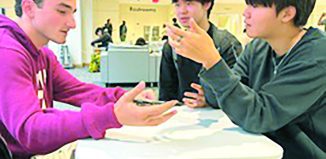Three Village Teens Debut Print Art Magazine
Looking for a way to connect young artists during a time when schools are unable to hold art shows, three Ward Melville High School students decided to give creative teens a chance to share their work, not only on the web but also in print.
In December, a new magazine called Junk Dump premiered. The publication was founded by Grace Brouillet, 17, of Port Jefferson Station, Dlisah Lapidus, 16, of Setauket, and Mia Schoolman, 16, of Stony Brook. Brouillet and Schoolman are seniors, while Lapidus is a junior set to graduate a year early.
Featuring artwork, photography, fashion designs and writings, the magazine has no ads, as the girls put up their own money to have it published. They used the online service PrintingCenterUSA to have it printed.
The three said the hope was to recoup some of the outlay by charging $10 for the full-color magazine. While they printed 75 issues of the first edition, titled Distorted Time, they had so many people interested that they are planning to print more of their second issue which is set to be released in February.
Schoolman said they chose the name Junk Dump because they wanted the magazine to be a place where artists could share anything, even if their piece wasn’t completed. Or, as she described it, “a place where artists can dump their work and show the raw side of their artwork.”
“We love unfinished or unpolished work, and you never get to see that in exhibits or art shows,” she said.
It’s no surprise that the girls became interested in creating a publication. Schoolman said she’s into studying the fine arts, and she and Brouillet are interested in graphic design. Brouillet is also editor-in-chief of the school’s yearbook. Lapidus said her interests lie in journalism and fashion design.
Lapidus said the objective was to show all talents whether one is an artist, writer, photographer or designer.
“That was really the goal — we wanted to just give every person who had some creative aspirations a place where they can express themselves and get some recognition for it,” she said.
The magazine features work from teenagers all over the country and the world, even as far as Turkey and Scotland. The three invited people to contribute via Snapchat, and the submissions have also led to an Instagram page and website. Schoolman said they also messaged some young artists directly.
Lapidus said they wanted to include young artists from all over the world as they recognized that with current restrictions due to COVID-19, many don’t have a place to express themselves, something they have witnessed firsthand with school art shows not taking place during the pandemic.
“It would be really interesting to see in this digital age that we have, and where face-to-face contact is restricted,” Lapidus said. “I think we can form a community through this magazine that doesn’t have to just be restricted by geography. It doesn’t have to be just in this area. We can even connect people here to all over the world.”
The high school students plan to publish the magazine every other month, and next year when they’re in college they still intend to produce more issues, Brouillet said.
“I think this is something that we’re all really passionate about and love doing, and we all feel it’s making a difference in our own lives and other peoples’,” she said. “When we go off to college, we’ll be able to build a community even bigger and keep it growing.”
Even though the girls run a website and social media accounts, presenting work in print is important to them, especially to Lapidus, a self-described avid reader, who said she’s always connected more with print media than online.
“It’s just not the same as holding paper in your hand,” she said.
She added so many magazines are online, but during the pandemic having a print version made sense.
“I thought when physical contact is taken from us with this pandemic, it’s important to bring print back in some way, and I think that having a physical print magazine connects people even further,” Lapidus said.
Schoolman said Lapidus’ passion for print, along with her and Brouillet’s graphic-design abilities are a good match.
“I think that when we first started the project, not many people really knew what we were doing,” Schoolman said. “We said we were making a magazine but obviously we didn’t have the physical copy in our hands [at the time]. I think when people actually see us go into publishing, printing our own magazine, it’s so important to kind of combine the digital world with the physical world.”
For more information on Junk Dump magazine, visit www.junkdumpmag.com.







